Introduction to Smoked Turkey Wings
Smoked turkey wings are a timeless favorite, beloved for their smoky, savory flavor and tender texture. Perfect for family gatherings, BBQs, or casual dinners, these wings are versatile and packed with protein. Smoking enhances the natural richness of turkey wings, making them a go-to choice for food enthusiasts who enjoy flavorful and healthy options.
Ingredients and Equipment Needed
Now that you’re sold on smoked turkey wings, let’s talk about what you’ll need to make them. Don’t worry—it’s not as complicated as you might think. Here’s your grocery list and gear checklist.

Essential Ingredients for Smoked Turkey Wings
To make perfectly smoked turkey wings, you’ll need high-quality ingredients that highlight their natural flavor:
- Turkey Wings: Aim for fresh, plump wings. If you’re buying frozen, ensure they’re fully thawed before smoking.
- Dry Rub: This is where the magic happens. Classic rubs typically include a mix of paprika, garlic powder, onion powder, black pepper, and salt. Feel free to add your own twist with cayenne, brown sugar, or cumin.
- Brine: A simple mix of water, salt, and sugar helps tenderize the meat and lock in moisture.
- Marinade (optional): For added flavor, consider a citrus-based or herb-infused marinade.
Tools and Equipment Required
- Smoker: Whether it’s a pellet smoker, charcoal smoker, or electric one, any model will do. Just ensure you know how to control its temperature.
- Wood Chips: Hickory and applewood are classic choices for turkey wings, but feel free to experiment with cherry or mesquite for unique flavors.
- Meat Thermometer: An absolute must to ensure your wings are cooked to perfection.
- Grill Tongs and Gloves: You’ll need these for safe handling.
- Drip Pan: To catch drippings and keep your smoker clean.
Having the right ingredients and tools not only makes the process smoother but also ensures your turkey wings turn out exactly as you imagine—juicy, smoky, and full of flavor.
How to Choose the Best Turkey Wings
Great smoked turkey wings start with the right wings. But with so many options at the store, how do you choose? Here’s what to look for:
Tips for Selecting Fresh and High-Quality Turkey Wings
Fresh turkey wings are key to a successful smoking session. Look for smooth, unblemished skin and a neutral aroma. Quality turkey wings result in rich, smoky flavor when smoked.
- Look for Freshness: Fresh wings should have a clean, neutral smell. Avoid any with a sour or “off” odor.
- Check the Skin: The skin should be smooth and free of bruises or tears. A dry or sticky texture is a red flag.
- Size Matters: Choose wings of similar size so they cook evenly. Smaller wings are great for faster cooking, while larger ones deliver more meat.
Frozen vs. Fresh Wings: Which Is Better?
There’s no definitive answer here—it depends on your schedule and preferences. Fresh wings are convenient and save you the thawing time. On the other hand, frozen wings can be just as good if properly thawed. Just remember: thaw them in the fridge for 24–48 hours to avoid uneven defrosting.
Now that you’ve got your wings ready, let’s dive into prepping them for the smoker. The next step? Ensuring every bite is packed with flavor.
Preparing Smoked Turkey Wings
Preparation is the key to turning ordinary turkey wings into a mouthwatering delight. From cleaning the wings to seasoning them with a perfect blend of spices, every step matters. Let’s break down the process to ensure you’re set up for success.
Cleaning and Brining Turkey Wings

Brining is a critical step to ensure your smoked turkey wings stay moist and tender. A salt-and-sugar brine infuses flavor into every bite, preparing the wings for the smoking process.
Brining is a game-changer. It keeps the meat moist and tender during smoking. Here’s a simple brine recipe you can follow:
- Ingredients:
- 4 cups of water
- 1/4 cup kosher salt
- 1/4 cup sugar (white or brown)
- Optional: Herbs like rosemary, thyme, or bay leaves for extra flavor.
- Steps:
- Combine water, salt, and sugar in a pot. Stir until fully dissolved.
- Let the mixture cool completely before submerging the wings.
- Cover the container and refrigerate for 6–12 hours. Overnight is best for deeper flavor absorption.
After brining, rinse the wings to remove excess salt and pat them dry again. This prevents overly salty results and ensures a better crust when smoking.
Creating the Perfect Rub for Flavor
Dry rubs are essential for enhancing the taste of smoked turkey wings. Use a blend of paprika, garlic powder, and brown sugar for a balanced mix of smoky, sweet, and spicy flavors. Here’s a classic rub to get started:
- Classic Dry Rub Recipe:
- 2 tbsp paprika
- 1 tbsp garlic powder
- 1 tbsp onion powder
- 1 tsp cayenne pepper (optional, for heat)
- 1 tbsp black pepper
- 1 tbsp brown sugar (for a hint of sweetness)
- 1 tbsp kosher salt
Mix all the ingredients in a bowl, and generously coat the turkey wings. Make sure to rub it into every nook and cranny—this ensures even flavor distribution.
If you’re feeling adventurous, try variations like Cajun seasoning, lemon-pepper blends, or even a jerk-style rub for a Caribbean twist.
Injecting Turkey Wings with Marinades
Want to take your wings to the next level? Injecting marinades into the meat ensures intense flavor with every bite. This step is optional but highly recommended for a gourmet touch.
- How to Do It:
- Use a marinade injector, available at most kitchen supply stores.
- Fill the injector with a liquid marinade—think garlic butter, herb-infused olive oil, or a citrus blend.
- Insert the needle into the thickest parts of the wings, injecting slowly to prevent spillage.
Marinating adds depth to the flavor profile and keeps the wings juicy throughout the smoking process.
Smoking Techniques and Methods
With the wings prepped and seasoned, it’s time to move onto the smoking process. This is where the magic happens, turning your seasoned wings into smoky, tender perfection.
Overview of Different Smoking Techniques

Not all smokers are created equal, and the method you choose impacts the flavor and texture of your wings. Let’s explore the options:
- Charcoal Smokers: Perfect for achieving a rich, traditional smoky flavor. They require a bit more attention to maintain temperature but are worth the effort.
- Pellet Smokers: User-friendly and consistent, pellet smokers offer precise temperature control with a variety of wood pellet flavors.
- Electric Smokers: Great for beginners, these provide consistent results with minimal supervision.
Choose a smoker that fits your experience level and the flavor you’re aiming for.
Using a Smoker: Charcoal, Electric, or Pellet
Regardless of the type, here’s a general guide to using your smoker:
- Preheat: Heat the smoker to 225–250°F. This low-and-slow temperature is ideal for turkey wings.
- Add Wood Chips: For a mild flavor, use applewood or cherrywood. Hickory and mesquite are stronger and deliver a bold, smoky punch.
- Place a Drip Pan: This catches drippings and helps retain moisture in the smoker.
- Position the Wings: Arrange the wings on the smoker’s rack, leaving space for even airflow.
Achieving the Right Temperature and Smoke Level
Temperature control is critical when smoking turkey wings. Too high, and you risk drying them out; too low, and they won’t cook evenly. Use a meat thermometer to track the internal temperature. The goal? A safe internal temp of 165°F in the thickest part of the wing.
- Pro Tip: Keep an eye on the color of the smoke. Thin, bluish smoke delivers the best flavor. Thick, white smoke can make the wings taste bitter.
Cooking Times and Temperatures
Perfectly smoked turkey wings aren’t just about the right seasoning or rub; getting the cooking times and temperatures just right is critical. This step ensures your wings are juicy, tender, and safe to eat.
Ideal Temperature for Perfectly Cooked Smoked Turkey Wings
Low and slow is the mantra for smoking turkey wings. Set your smoker to 225°F to 250°F. This temperature allows the wings to cook gently while absorbing all the smoky goodness. The goal is an internal temperature of 165°F at the thickest part of the wing. Use a meat thermometer to check this—there’s no guessing when it comes to food safety!
How to Use a Meat Thermometer Correctly
A meat thermometer is your best friend when smoking turkey wings. Here’s how to use it effectively:
- Insert the thermometer into the thickest part of the wing, avoiding the bone.
- Check the temperature without opening the smoker too often. Each time you lift the lid, heat escapes, which can increase cooking time.
- Once the thermometer reads 165°F, your wings are ready to be pulled from the smoker.
- Pro Tip: If you don’t own a meat thermometer, it’s worth investing in one. It takes the guesswork out of cooking and ensures food safety.
Adjusting Cooking Times Based on Wing Size
The size of your turkey wings plays a significant role in cooking times. Here’s a general guideline:
- Small Wings: 1.5 to 2 hours at 225°F
- Medium Wings: 2 to 2.5 hours at 225°F
- Large Wings: 2.5 to 3 hours at 225°F
Keep in mind that external factors like smoker efficiency, weather conditions, and the type of wood chips can slightly alter cooking times. Always rely on the thermometer for accuracy.
Common Mistakes to Avoid
Even with the best intentions, mistakes can happen when smoking turkey wings. Avoiding these common pitfalls will ensure your wings turn out perfect every time.
Over-Smoking or Under-Smoking Issues
One of the most common mistakes is using too much or too little smoke. Over-smoking can result in a bitter taste, while under-smoking leaves the wings lacking that distinct smoky flavor.
- Solution: Use thin, blue smoke for a balanced flavor. Avoid thick, white smoke, as it often contains impurities that can create bitterness. Add wood chips gradually instead of overloading the smoker at the start.
Common Brining and Seasoning Errors
Skipping the brining process or applying uneven seasoning can lead to dry or bland wings.
- Solution: Always brine your wings to ensure they stay juicy. When applying the dry rub, don’t be stingy—make sure every part of the wing is coated evenly. Massage the rub into the skin to help the flavors penetrate.
Tips for Avoiding Dry Wings
Dry turkey wings can ruin the experience, but there are easy ways to keep them moist.
- Solution: Use a water pan in your smoker to maintain humidity. Basting the wings with melted butter or apple juice every hour also helps lock in moisture. Remember, low and slow cooking is the key.
Storing and Reheating Leftovers
Got leftover wings? Don’t let them go to waste. Proper storage and reheating techniques ensure they’re just as tasty the next day.
Proper Storage Techniques for Smoked Turkey Wings
- Refrigeration: Place leftover wings in an airtight container and store them in the fridge. They’ll stay fresh for up to 3 days.
- Freezing: For longer storage, wrap the wings tightly in foil or plastic wrap, then place them in a freezer bag. They’ll keep for up to 3 months.
- Pro Tip: Label your containers with the date to avoid confusion later.
Best Practices for Reheating Without Losing Flavor
Reheating smoked turkey wings can be tricky—you don’t want them to dry out. Here’s how to do it right:
- Oven Method: Preheat the oven to 325°F. Wrap the wings in foil and heat for 15–20 minutes. Add a splash of broth or water before wrapping to retain moisture.
- Microwave Method: While quicker, the microwave can make wings rubbery. Use low power and heat in short bursts, adding a damp paper towel over the wings to keep them moist.
- Air Fryer Method: For a crispier texture, reheat wings in an air fryer at 350°F for about 5–7 minutes.
For a complete culinary experience with turkey wings, explore this Turkey Wings Recipe Made Easy, which provides additional tips on flavor pairings and preparation techniques. For a comforting and indulgent twist, try Smothered Turkey Wings—an excellent choice for hearty family meals. For those who love smoky flavors but want to expand their BBQ repertoire, check out our BBQ Shrimp Recipe Ultimate Guide for techniques that translate well to other proteins.
FAQs About Smoked Turkey Wings
How long does it take to smoke turkey wings?
Smoked turkey wings typically take 2 to 3 hours to cook at a consistent temperature of 225°F to 250°F. The exact time depends on the size of the wings and your smoker’s efficiency. Always use a meat thermometer to verify that the internal temperature reaches 165°F, ensuring safe consumption.
Are smoked turkey wings fully cooked?
Not all smoked turkey wings are fully cooked. If you purchase pre-smoked turkey wings, check the label to see if they are labeled “fully cooked” or “ready to eat.” If you’re smoking them at home, they’re considered fully cooked once the internal temperature reaches 165°F.
Why are my smoked turkey wings tough?
Tough smoked turkey wings are often the result of cooking at too high a temperature or not cooking long enough. Smoking requires a low and slow approach to allow the collagen in the meat to break down, resulting in tender wings. Ensure your smoker stays between 225°F and 250°F and allow ample time for the wings to cook.
How long do smoked wings take at 225?
At 225°F, smoked turkey wings generally take 2 to 2.5 hours to cook. The timing can vary based on the size of the wings and your smoker’s performance. Always use a meat thermometer to confirm the internal temperature hits 165°F before serving.
Conclusion and Final Thoughts
Smoking turkey wings might take a bit of time and effort, but the results are undeniably worth it. The tender meat, smoky aroma, and perfectly seasoned crust are enough to impress any crowd. Whether you’re hosting a BBQ or enjoying them as a weeknight treat, smoked turkey wings are a versatile, delicious option that never disappoints.
If you’re new to smoking, don’t be intimidated—start with the basics, experiment with flavors, and have fun. After all, great food is all about enjoying the process as much as the result. So fire up that smoker and let your culinary adventure begin!

